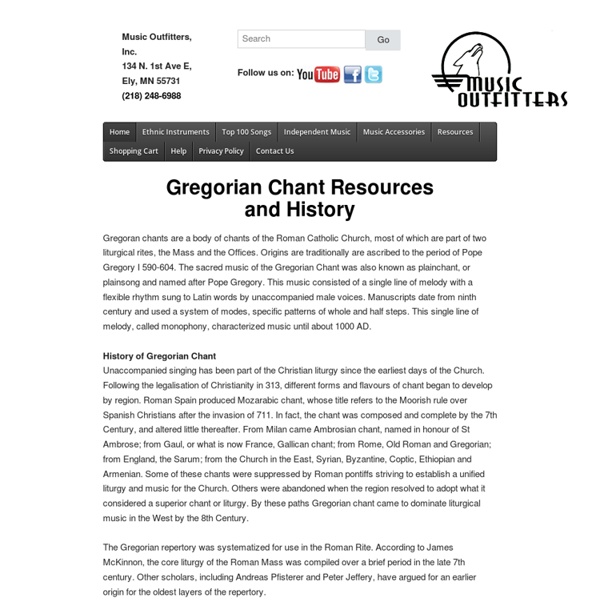Gregorian Chant Resources and History

http://www.musicoutfitters.com/gregorianchants.htm
Gregorian Chant Lyrics - Attende Domine - traditional famous Catholic Lenten hymn Lent song
Attende Domine Attende Domine, et miserere, quia peccavimus tibi. Attende Domine, et miserere, quia peccavimus tibi. Ad te Rex summe, omnium Redemptor, oculos nostros sublevamus flentes: exaudi, Christe, supplicantum preces. Attende Domine, et miserere, quia peccavimus tibi.
Gregorian chant
Gregorian chant is the central tradition of Western plainchant, a form of monophonic, unaccompanied sacred song of the western Roman Catholic Church. Gregorian chant developed mainly in western and central Europe during the 9th and 10th centuries, with later additions and redactions. Although popular legend credits Pope St. Gregory the Great with inventing Gregorian chant, scholars believe that it arose from a later Carolingian synthesis of Roman chant and Gallican chant. History[edit]
The Influence of Gregorian Chant Through Today
Gregorian chant is a central tradition chant of Western Christianity that came into existence for that ritual services and mass celebrations. Gregorian chant originated in the West Germanic tribes, the areas of western and central Europe during 12th-13th century. Pope Gregory is believed to be the originator of Gregorian music.
Why is chant called Gregorian?
That "Gregorian" chant was named for and credited to Pope Gregory I (r. 590-604) is an accident of politics and spin doctoring. Tension between the Pope (the Bishop of Rome) and other Bishops regarding the authority of the Pope as "first among equals" was matched by tension between the Pope, as spiritual ruler of Rome, and Rome's secular rulers. This tension was an off and on thing until as late as the 15th century, when the "Conciliar Conflict" (c. 1409-1460) pitted the power of the Council of Bishops against the power of the Pope and Cardinals. Gregory I has been credited with many things, including the writing, collecting, or organizing of the body of plainchant in use at the time, as well founding the first singing school (Schola Cantorum) in Rome to train singers for the church, organizing the church's annual cycle of liturgical readings, and first establishing the church's authority over the secular rulers of Rome.
Gregorian Chant Home Page
on the World Wide Web "in omnem terram exivit sonus eorum, et in fines orbis terrae verba eorum" Psalmus 18:5 [RSV 19:4] The Return of the Tridentine Mass On July 7, 2007, Pope Benedict XVI issued the Apostolic Letter motu proprio Summorum Pontificum , which permits most priests to celebrate the Roman Missal of 1962 (the last edition of the Tridentine Mass issued before Vatican II) without obtaining special permission.
Abbaye de Solesmes - Histoire du Chant Grégorien
Gregorian Chant is a musical repertory made up of chants used in the liturgical services of the Roman Catholic Church. In fact, the liturgical tradition which the Church has given us is a vocal, monophonic music composed in Latin using sacred texts from the Ancient and New Testaments. This is why Gregorian Chant has often been called a "sung Bible". Linked intimately to the liturgy in this way, the goal of the Gregorian melodies is to favor spiritual growth, reveal the gifts of God and the full coherence of the Christian message. What we call Gregorian chant today first appears distinctly in the Roman repertory of the fifth and sixth centuries. Its implimentation and perhaps some of its composition was in the hands of a group of ministers in a service specially dedicated to the Roman basilicas, the schola cantorum.
GLOBAL CHANT DATABASE - Index of Gregorian Chant - Homepage
Related:
Related:



